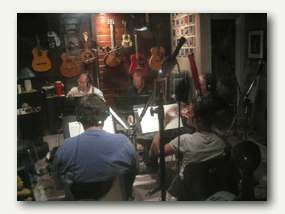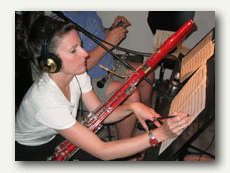by Gary Powell

Ensemble: Wild Basin Winds
Recording Dates: 4/10,11,13/2005
Click Here for Session Photos
The woodwind quintet ensemble (flute, clarinet, oboe, horn, bassoon) creates a unique challenge in the recording studio. The flute speaks upward, the clarinet speaks downward, the oboe speaks downward, the horn speaks to the rear and the bassoon speaks from the middle of the instument for its middle range and speaks upward for its lower register. Sonically, in my space the horn’s warm sound permeated the room and the oboe’s lanquid sound bleeds into all the microphones. The accepted method is to record this ensemble with the classical setup of a stereo pair about 10 feet in front of the group. This traditional setup asks a lot from the room to do the mixing for you. Fine if the room sounds good, but this will not produce a sound with the kind of presence that I wanted. A quick call to engineer guru, Larry Seyer, helped me try both setups described below. Wild Basin Winds was recording Christmas arrangements by Gary Slechta. Half of these beautifully written charts were classical in nature and the other half were written in a very creative swing big band style. Amazingly enough, these players were adept in both styles.

Classical Setup: Two stereo pair. The first pair was parallel with the foward most players (oboe/flute) and about 5 feet above. The second pair was at the same height, but about 3 feet behind the rear most player (horn).
Swing Band Setup: Each player was individually mic’d in accordanced with the characteristics of each instrument mentioned above. FLUTE: (AKG414) placed 3 feet above. CLARINET: (AKG414) 1 foot below the bell. HORN: (Audio Technica 4033a) 3 feet behind the bell. BASSOON: (Audix i5) 1 foot directed mid-instrument. OBOE: (Rode NTV) 1 foot below the bell.
Using two different setups worked well because of the dual nature of Gary Slechta’s charts. However, if I had it to do over, I would choose the Swing Band setup with the invidual microphones with its ability to sculpt the mix. I also prefer the close mic’d sound, even for classical ensembles. This preference is not widely shared, however.
We also optioned many microphones and all seemed happy with the final choices listed above. My thanks to Mathew Krejci (Flute), Gary Sperl (Clarinet), Tom Hale (Horn), Daris Word Hale (Bassoon), Ian Davidson (Oboe) and Gary Slechta (Arranger) for three fun, musically inspiring days with outstanding musicians and musicianship.
by Gary Powell

Ensemble: Wild Basin Winds
Recording Dates: 4/10,11,13/2005
Click Here for Session Photos
The woodwind quintet ensemble (flute, clarinet, oboe, horn, bassoon) creates a unique challenge in the recording studio. The flute speaks upward, the clarinet speaks downward, the oboe speaks downward, the horn speaks to the rear and the bassoon speaks from the middle of the instument for its middle range and speaks upward for its lower register. Sonically, in my space the horn’s warm sound permeated the room and the oboe’s lanquid sound bleeds into all the microphones. The accepted method is to record this ensemble with the classical setup of a stereo pair about 10 feet in front of the group. This traditional setup asks a lot from the room to do the mixing for you. Fine if the room sounds good, but this will not produce a sound with the kind of presence that I wanted. A quick call to engineer guru, Larry Seyer, helped me try both setups described below. Wild Basin Winds was recording Christmas arrangements by Gary Slechta. Half of these beautifully written charts were classical in nature and the other half were written in a very creative swing big band style. Amazingly enough, these players were adept in both styles.

Classical Setup: Two stereo pair. The first pair was parallel with the foward most players (oboe/flute) and about 5 feet above. The second pair was at the same height, but about 3 feet behind the rear most player (horn).
Swing Band Setup: Each player was individually mic’d in accordanced with the characteristics of each instrument mentioned above. FLUTE: (AKG414) placed 3 feet above. CLARINET: (AKG414) 1 foot below the bell. HORN: (Audio Technica 4033a) 3 feet behind the bell. BASSOON: (Audix i5) 1 foot directed mid-instrument. OBOE: (Rode NTV) 1 foot below the bell.
Using two different setups worked well because of the dual nature of Gary Slechta’s charts. However, if I had it to do over, I would choose the Swing Band setup with the invidual microphones with its ability to sculpt the mix. I also prefer the close mic’d sound, even for classical ensembles. This preference is not widely shared, however.
We also optioned many microphones and all seemed happy with the final choices listed above. My thanks to Mathew Krejci (Flute), Gary Sperl (Clarinet), Tom Hale (Horn), Daris Word Hale (Bassoon), Ian Davidson (Oboe) and Gary Slechta (Arranger) for three fun, musically inspiring days with outstanding musicians and musicianship.


GP,
Thanks for mentioning my name in your blog!
Things are looking good here.
I can’t wait to hear the recording.
BTW, I’m researching doing a PODCAST… when I find out more about it, I’ll share.
Best to you!
Larry
Wow. I like to read articles of this nature. Too often the specifics of a recording session are cast aside as a point of little interest. I for one am curious to see and hear exactly how recording scenarios turn out. Thanks for the article.
kiv